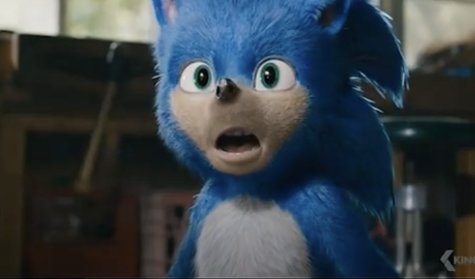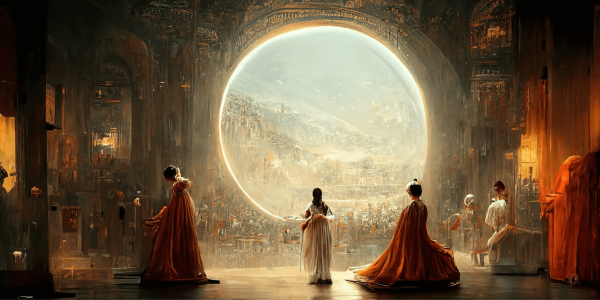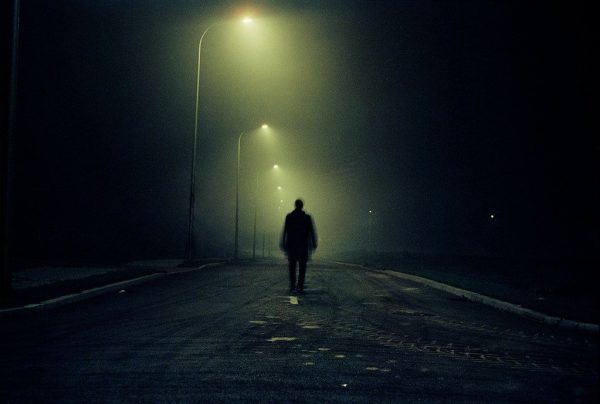The Sun is Shining Again
Yesterday, sitting in an audience of hundreds was a normality. Now, it’s a mere memory. Maybe it was fate, or perhaps someone was audacious enough to utter “Macbeth” on stage. Regardless of superstition, though, the Eye of the Storm Productions has been forced to alter the performances of last Spring’s musical, Bright Star. With two exclusive live performances and a filmed production on the way, the upcoming show nights – both pre-recorded and live – pose an unexpected situation that these performers have not yet experienced.
From sizing down the cast, recasting, rebuilding the sets, and filming the production, I intimately followed the process of bringing this musical from the stage to the screens — a remarkable feat only the best of theater companies could accomplish. And though I may be slightly biased for the sake of school pride, I’m fully confident in my statement that the Eye of the Storm Productions is the best of the best. Needless to say, their story is one of inspiration and success.
Striking the Sets
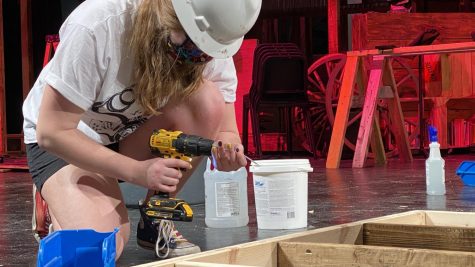
The Eye of the Storm Productions is unique in the sense that they build their remarkable sets, costumes, and props almost entirely from raw materials. On the Friday afternoons dedicated to this process, it used to be a noisy and energetic affair, with about 35-40 people laboring on the sets and costumes each tech day. At the time of their first tech day this year, however, Covid regulations required the company to size down their group to less than ten workers a session.
On the first tech day of 2021, taking place exactly one year after the show was postponed from March 13, the crew’s job was to take down parts of the original set of Bright Star. They were to use those materials to create smaller platforms for filming purposes, all while adhering to Mr. Anderson’s reminders to stay six feet apart.

Striking the sets is an emotional experience by any means, but doing so before the sets have seen an audience is undoubtedly disappointing to the cast. “We’ve spent a lot of time working on these sets,” LeOra Ziegler, a junior, explains as she measures a new platform. “I spent my entire last day of school before Covid painting and working on these sets, so it’s sad to take them down. But I’m excited that we still have the opportunity to do our show, so I’m very grateful for that.”
“It’s bittersweet,” another cast member admits. “We’ve put a lot of work into this, but at the same time it’s nice that this show can receive a second life.” Through all this struggle and effort to keep the show running, it’s refreshing to see such optimism and gratitude radiate from the cast members when given a task as difficult as this.
Recasting

With 2020’s seniors long gone, there have been many vacant roles to fill with this new production of Bright Star. Last year’s phenomenal senior leads and other supporting roles include Logan Perry, Kellan Koch, Austin Jackson, Gabriel Matthews, and Abby Gibbons. (Not to mention many more senior ensemble members, choreographers, and stage managers.) It was devastating to see them go without their final high school musical, especially when the hours and years it took for them to earn their lead are considered. But as we’re well aware, “the show must go on.”
Many current company members spent last spring’s rehearsals observing the seniors perform and perfect their lead roles. Now, a select few have auditioned and are taking on these roles themselves, which is assuredly an atypical experience. Not only are these actors facing greater time constraints, but they also have to use this shortened time period to navigate an entirely new character.
Jonah Caudle, who has been in the theater business ever since his breaking role in his fifth-grade production of The Lion King Junior, is grateful to earn a new role. Originally played by Senior Isaac Reck, Caudle now plays Daddy Murphy, the father of our protagonist, Alice Murphy. “There’s a lot that [Isaac] did well, but I have to get into the mentality and remind myself that this isn’t his character anymore, this is my character.” Nevertheless, he expressed great excitement at the prospect of discovering the intricacies of this new role for himself. “I already got to see [Bright Star] once, because we were on the verge of performance. But now, it’s almost like I get to rewrite the character myself.” However, though Junior Alyssa Vasko assures that the show will be of excellent quality, she notes that, “It’s still going to be challenging to perfect [our] parts in a shorter period of time.” But when EOTSP’s track record is considered, we have no reason to doubt Vasko’s confidence.
Perhaps the greatest change in recasting lies in the combination of the roles of the female protagonist, Young Alice and Older Alice. As these two roles were initially split and played by Senior Emily Brosofski and Logan Perry respectively, Perry’s 2020 graduation has prompted Mr. Anderson to make the decision to allow these two roles to be played by one actress, Emily Brosofski. Although it was somewhat difficult to adapt to more time on stage, Brosofski says, “[The] lines and songs came fairly quick since I was familiar with it already just by being in the show last year.” She notes it has been “wildly enjoyable,” to perform with her peers one last time. “Taking on both the 16-year-old and almost 40-year-old versions of the same character… has been such a unique and educational experience. I’m honored to go out with a bang.”
Outdoor Rehearsals
 It’s a late April afternoon and the unforgiving sun is a scorching eighty-five degrees. Due to Covid restrictions, the company has to rehearse, masked, in Huntingtown’s courtyard while enduring the heat of the afternoon. Luckily, most don’t seem too concerned. “I don’t mind performing outside,” Peter Nowak explains. “The weather is pretty unpredictable, but you just have to adjust to it.” However, Sophomore Austin Hickey notes, “I do think I will be hotter performing outside with jeans and flannel.” (He clarifies that he means thermally, not in a physical sense.) In spite of these new developments, the cast puts on sunscreen to prevent the very legitimate possibility of being baked alive. They space themselves out and take their places for the first scene.
It’s a late April afternoon and the unforgiving sun is a scorching eighty-five degrees. Due to Covid restrictions, the company has to rehearse, masked, in Huntingtown’s courtyard while enduring the heat of the afternoon. Luckily, most don’t seem too concerned. “I don’t mind performing outside,” Peter Nowak explains. “The weather is pretty unpredictable, but you just have to adjust to it.” However, Sophomore Austin Hickey notes, “I do think I will be hotter performing outside with jeans and flannel.” (He clarifies that he means thermally, not in a physical sense.) In spite of these new developments, the cast puts on sunscreen to prevent the very legitimate possibility of being baked alive. They space themselves out and take their places for the first scene.
It’s like they never left the stage.
“It took a few days to get them back on track,” admits their director, Mr. Anderson. Nevertheless, in five rehearsals or less, they nearly have it sounding ready for recording. “It’s in their subconscious.”
The cast has shrunk remarkably. From a company of more than eighty people, roughly twenty students remain, spaced out amongst themselves. Surprisingly, the ensemble sounds no less full, and the three remaining dancers move with no less vigor. “Thankfully,” Hickey says, “there’s been a lot of work by Mr. Anderson and others to keep this experience as normal as possible.”
Perhaps it’s the courtyard’s acoustics, Mrs. Greise’s and Mr. Anderson’s competence, or the sheer talent of this cast. Whatever the reason, though, these new rehearsal standards seem to be a mild price to pay for the performance to come.
Recording Bright Star
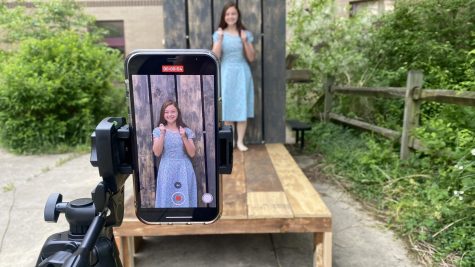
Typically, when one thinks of watching a theater performance, they don’t envision several small sets positioned around a courtyard, numerous cameras, and lighting trees surrounding the stage. Nevertheless, the sets have been divided and distributed into several smaller pieces about Huntingtown’s courtyard to ensure the filming of unmasked scenes can be recorded while remaining spaced out. Actors are instructed to look directly at the camera to give the illusion that they are communicating directly with each other, when in reality, they’re standing dozens of feet away. Brosofski claimed that looking directly ahead instead of addressing her partner, “really shifted the way in which I read and respond throughout the production.” Not only is this experience vastly different from how they normally perform, but many have mentioned the lack of energy that accompanies the recording of the performance.

“It will take out some of the adrenaline of a show night and the live feedback from the audience,” says Vasko. “But at the same time, it gives us the opportunity to perfect what we have with multiple takes.” In many ways, recording the production allows us to see the truest potential of this company as they are able to improve their performance after multiple takes. “I would say that you lose a little bit of humanity in splicing together footage,” Junior Zane Jacquot allows, “but the product value is high enough compared to a live performance that the humanity lost isn’t necessarily a big deal.”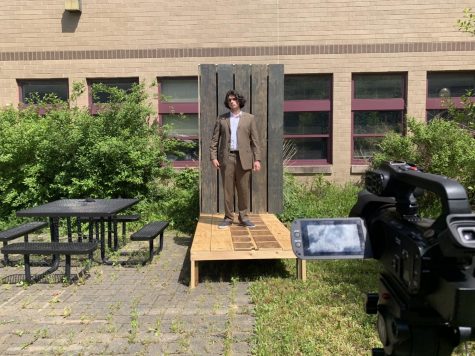
Jonah Caudle agrees with this popular sentiment. “The audience creates this sense of energy,” he explains, “which gets me in the mindset of my character more than any rehearsal can. But at the same time, I’m grateful we can do this show at all.” Caudle’s last remarks encompass the general grateful nature of the company as many members continue to express their continuous gratitude and excitement that they are still able to perform in any capacity.
Luckily, recent developments and the county’s loosened restrictions have allowed the Eye of the Storm Productions to hold two unmasked live performances on the 21st and 22nd of May. Though the audience members are limited to those in relation to cast members, it seems like the cast will feel a faction of that energy once more. “Though a change of pace for all of us,” Brosofski says, “I found it to be an enriching process.”
Theater performances demand not only to be seen, but to be experienced. Actors are vessels for our emotional release while dancers encompass the feelings that we cannot express with words. Everything in a production — from the lighting to the costumes to every conscious hitch in an actor’s voice — is purposely done to ensure that we, as an audience, are transported into the story. There are lessons to be taught by the physical, emotional, and spiritual proximity between the actors and audience – lessons that would have been thought impossible with CDC regulations. Yet, in my humble opinion, regardless of their physical distance, the Eye of the Storm’s actors have successfully achieved the seemingly impossible, albeit vital feeling of propinquity.
My name is Laura Vance and I’m a Senior at Huntingtown High School with an affinity for reading and British soap operas. I have a dog named Apollo and...

